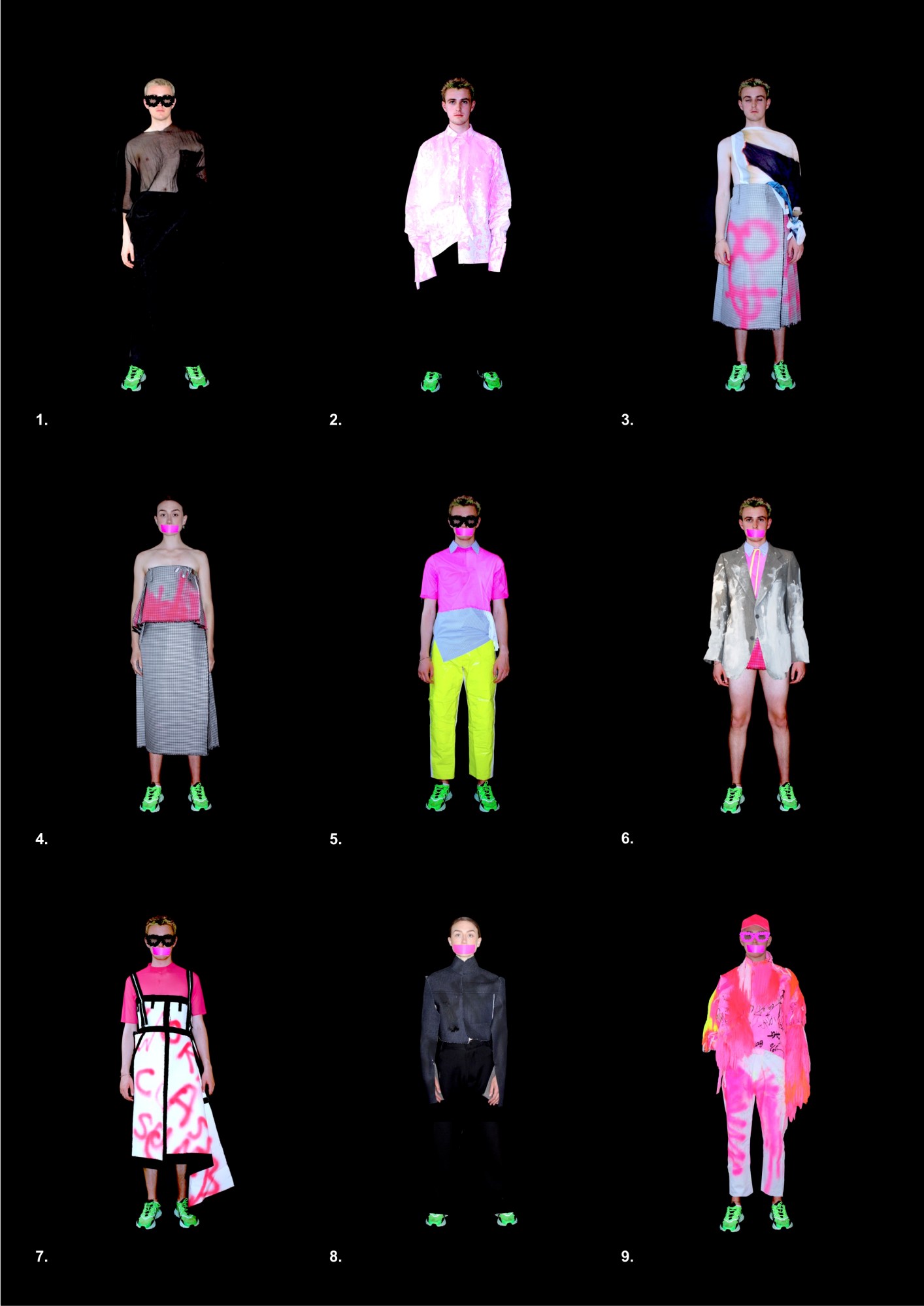“Throughout the period of lockdown, we’ve been conceiving ways of presenting ourselves and displaying our voices in a tone that speaks of our time,” Sam Jamieson, a graduate of the Royal College of Art’s MA Fashion Class of 2020, says. Like most other fashion graduates this year, Sam and his 50 classmates will be presenting their work on an online platform — a situation which, for many, is far from what they had in mind when first setting out on their courses.
If the past few months have taught us anything, though, it’s that clinging too tightly to previous plans and expectations only amplifies any sense of disappointment. Agility and flexibility are skills which have never been more vital — and for fashion students today, that doesn’t just apply to how they approach and execute their work, but to how they understand the purpose of their practices in the context of an ever-changing world. “The ‘show’ has not just been about one moment this year, but rather an archiving of a period that won’t be forgotten,” Sam says. “What was more interesting this year was documenting a memory of what we have gone through together and who we are as individuals within the world’s conversation.”
Images and videos of the class’ final collections are, of course, a major component of the RCA MA Fashion graduates’ participation in RCA2020, a digital discovery platform hosting the work of graduates from the RCA’s schools of Architecture, Arts & Humanities, Communication and Design. Just as crucial this year, however, is the accompanying programme of curated journeys, gestures, conversations and live events. Through these, a rare light is cast on the processes and experiences that have paved the way to this endpoint.
The dynamism that each of the school’s 51 fashion graduates has demonstrated is a testament to fashion’s “power of tenacity and curiosity beyond other realms of creativity,” Zowie Broach, Head of Fashion at the RCA says. “It attracts madness and a little stubbornness and plenty of unknowing. Fashion teaches us to adapt and be fluid when it is at its pure form of expression and liberty.” Of course, the journey to the finish line without physical access to the technicians, workshops, and general studio camaraderie and banter hasn’t always been the rosiest. “I would be ‘err’ not to mention that the whole process drove some crazy — missing the sense of touch, fall, smell, dance,” Zowie adds. “But for many, this pulled away their normalised ambition and allowed them to be more free. They could provoke, play and explore if willing — AND they did. These memories never leave, but they have, I believe, produced stronger, better thinkers and designers.”

Sissel Kärneskog
“My work always revolves around the physical human body, the emotional body and how these challenge the body of society. This year, I focused on including my own physical body, which was a challenge but also something that made me obtain a greater understanding of myself and the context I exist in.
“During this time I have acted as a subject and an object, exploring customisation through the visibility of one non-binary body. This is a visual argument that explains that there is a lot to learn, but so much more to unlearn. I am not only me, I am Them.
“As a non-binary queer identity existing in a society and system that is still rooted in the binary, my fight is for human rights. We exist in a time where we are fed with the daily reminder that our bodies are public property. We are fundamentally altered by the objectification around us, and we as humans are objectified in this space.

“My work tends to have theatrical aspects in its visual display, and I tend to get asked whether I do fashion design or costume design. I have always asked myself: ‘Why does fashion fear costume?’ since I believe that the constructed society that we exist in today has already placed you in one.
“Since the human body is the most obvious instrument for self-expression, and that what we place upon it are the most intimate objects we own, we can use this concept to provoke the constructed contexts that we exist in today. We have an opportunity and responsibility to pave the way for future generations to come. We must keep having social debate and discussion about the importance of diversity, inclusivity and equality. Action makes for change.”
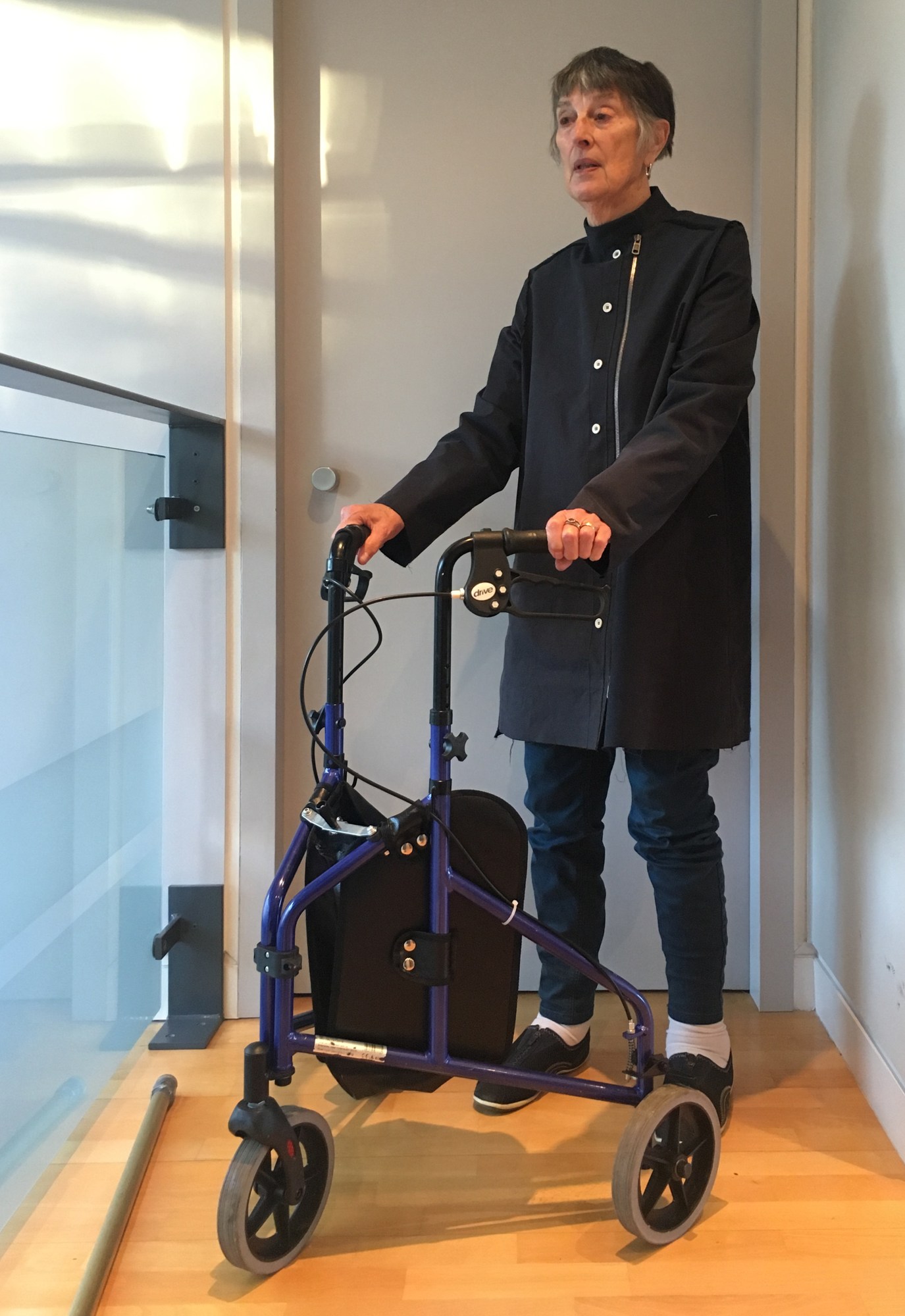
Ellen Fowles
“I’ve developed a wardrobe with and for my grandmother, Marian Fowles. It accommodates her life at home, in hospital and as a clinical outpatient. My intention was to provide her with garments that grant her the freedom to live according to her desires, rather than against the constraints of her clothing.
“So often Marian is forced to wear ill-fitting sportswear just because it’s easier to put on or because it’s more practical for her rehabilitation. I wanted to translate this function into our shared aesthetic. My designs prioritise the dignity of the wearer in a medical context. Whether in a healthcare facility, or for rehabilitation at home, it is fundamental that the clothing of both patients and staff is seen as a crucial part of the care environment. My aim is to create clothing that disabled and able-bodied people can both enjoy.
“We cannot stand for tokenistic displays of support for inclusion and equality that overshadow deeply faulted systems that are collapsing on themselves. The entire fashion industry needs to change. But I also consider the ethics of my own practice and question who am I to design for you? Today I am able-bodied, I might not be tomorrow.
“I’ve just started a design fellowship at the Open Style Lab which is a non-profit organisation based in New York. I’m collaborating with occupational therapists and engineers and co-designing with people from the Muscular Dystrophy Association. It’s a shame not to be able to work together physically at the Lab, but it’s been amazing to research and design with creatives from all over the world.”
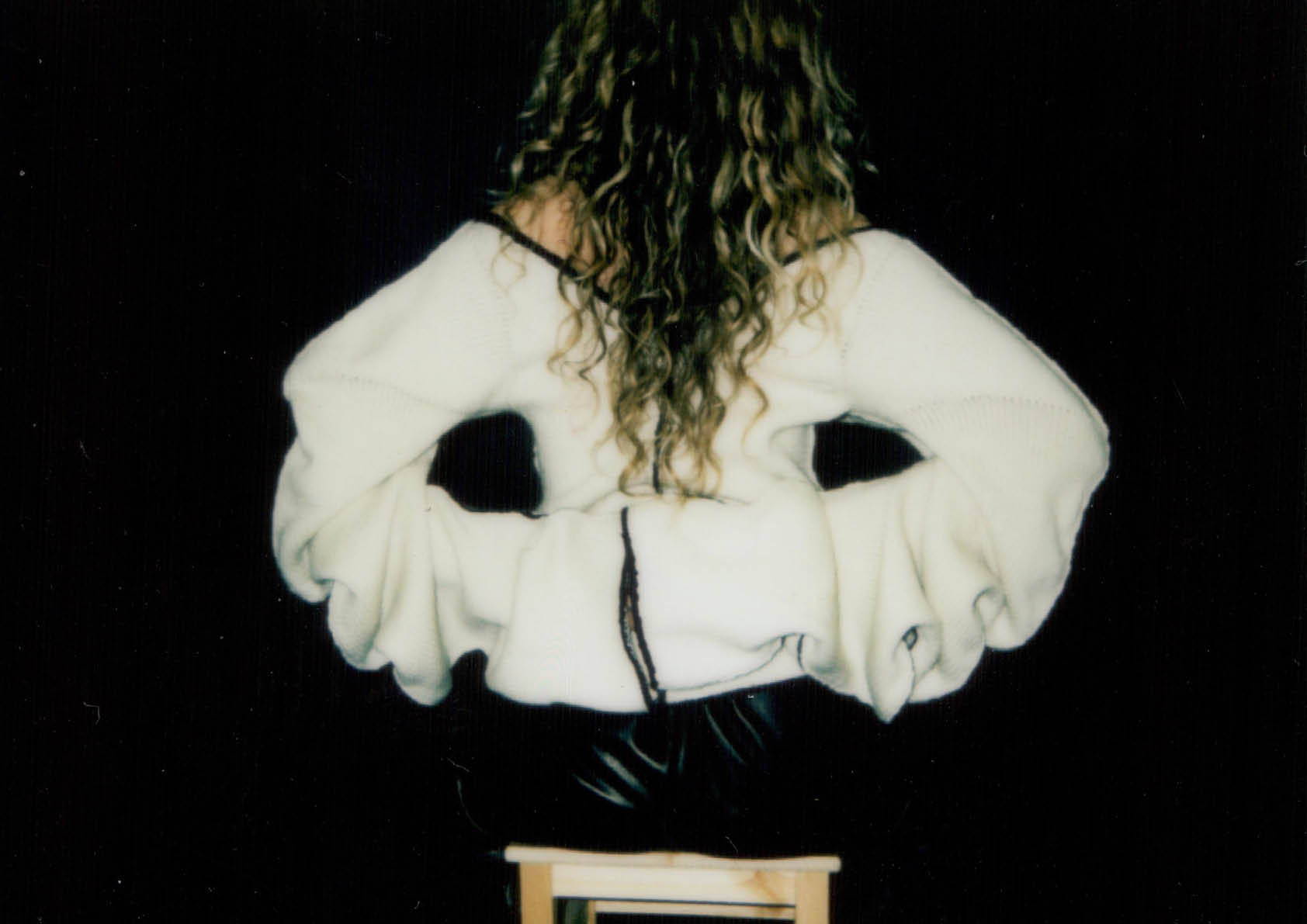
Amaranthe Frost
“Growing up in a collector’s house, I have always understood that collections speak volumes that could never be told in the medium of words. Collecting is never really about the accumulation of objects, but rather about building an archive of the experiences of one’s life, which in turn tells the personal story of the collector.
“Going back to my family home with my sister, I dressed myself in my mum’s collections: adorning myself with garments belonging to my mum, my granny, as well as old neighbours and friends of the family.
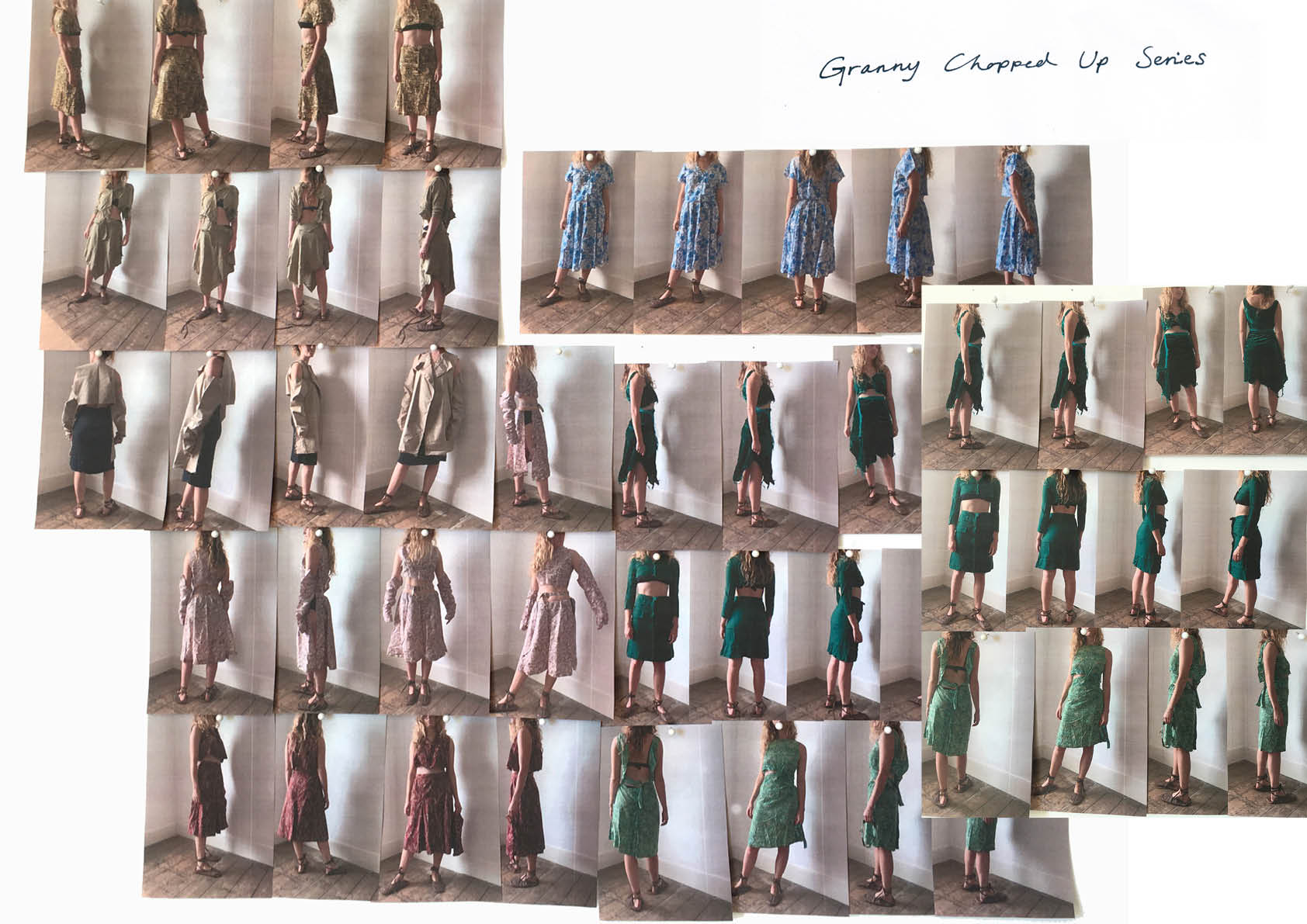
“Some dresses had been deconstructed to make something more wearable and perhaps more useful for a particular occasion. Many of the garments had been altered multiple times, perhaps to house the ever-changing pregnant body. Both my mum and granny had four children and it became increasingly apparent to me how resourceful these women were.
“For my final presentation, I kept to the Pre-COVID deadlines. We were meant to have our show on the 12th June, so I wanted to stick to that. I sent my collection back to where it had come from. I sent it back to my Mum who was in lockdown in the house I grew up in. I sent it to her via Royal Mail and asked her to set up an exhibition of my collection in the house. I gave her some instructions but also left room for interpretation. I had a private view, but a private view that only she saw and went to — a bit like her own collections which are hers and for her.”
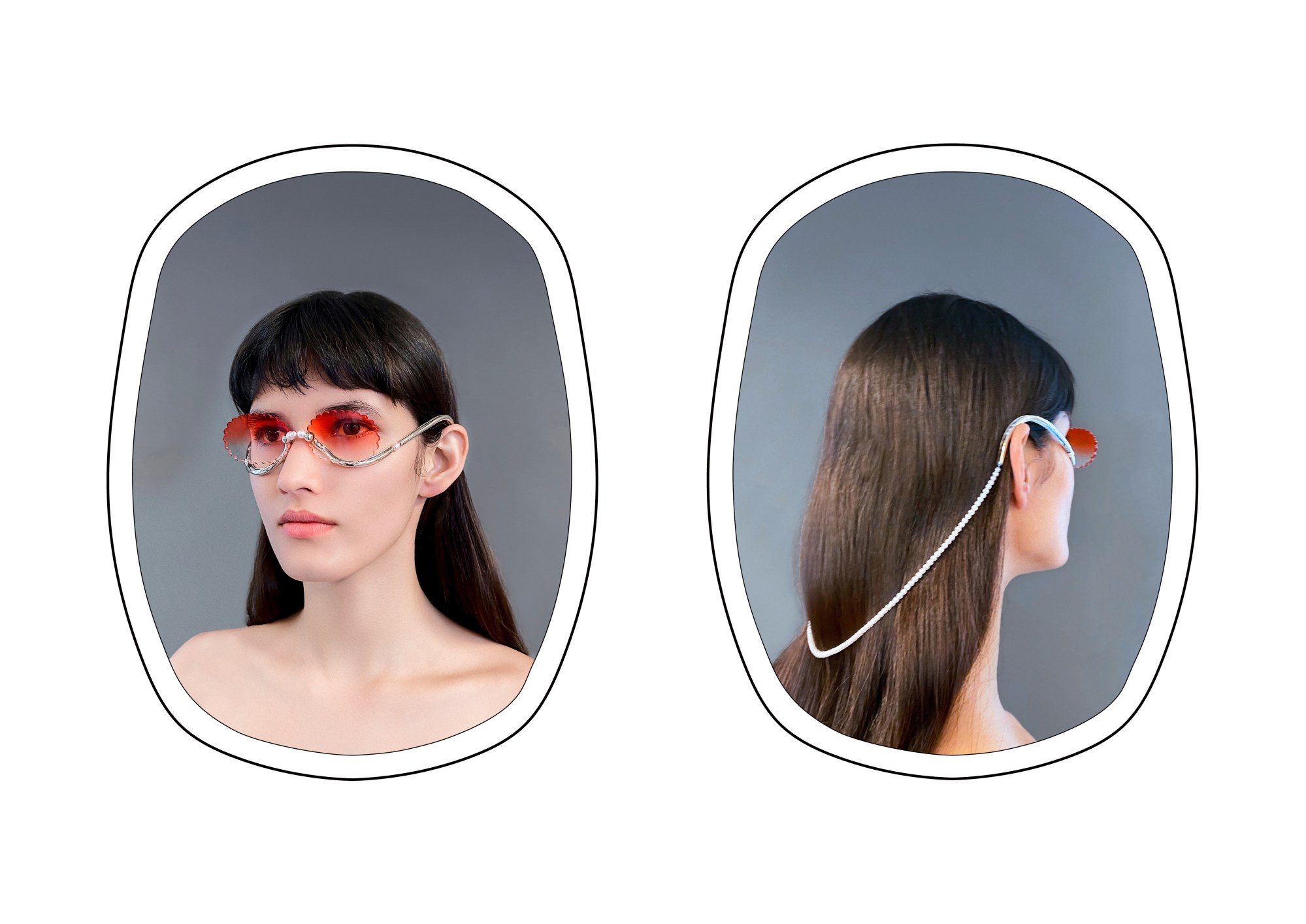
Ely Yili Cao
“My final collection, LUNETTE de DIADÈME, began with my awareness of how people’s appreciation of glasses has changed dramatically very recently — the social status of eyewear has moved upwards. In some cases, they are no less expensive than any other high-end luxury item. I use luxury as a perspective, and high-end jewellery as a platform, incorporating high-tech to convey and explore how eyewear has infiltrated into people’s dressing rooms. “My focus on eyewear was motivated by personal preference, as glasses are the only everyday accessory I wear, and the constant appearance of gems and jewellery elements reflects back on me being a gemologist and jeweller.
“For many years, glasses have generally served as a medical necessity rather than as fashion indulgence. In a certain era, though they were necessary equipment for many, glasses were still universally loathed as a sign of physical disability. In fashion, eyewear has only been taken seriously in the last few decades. This collection is reflecting how what was once treated as a sign of physical impairment has now become socially accepted, and has even become an aesthetic choice. “My practice has always been based on 3D manipulation: my design process is in a digital surround, while the making has always been more handcrafted. Due to current circumstances, and a lack of access to the necessary facilities, the latter was somewhat sacrificed. But I was able to grant more attention to the design process, and devote all the excess time to refining details.”
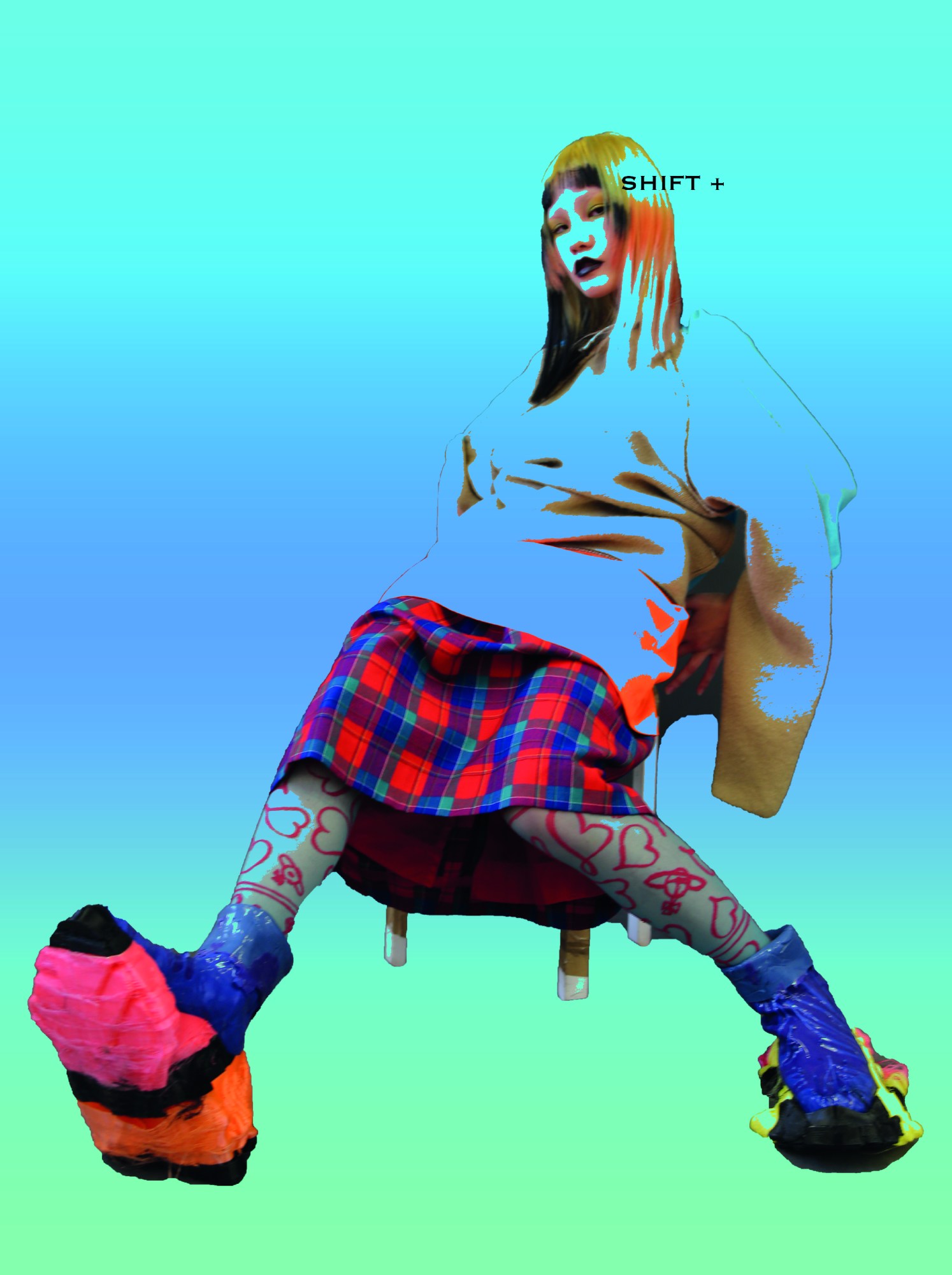
Yunfei Ma
“My collection is called “shift +”. My work is strongly inspired by Ghost in the Shell, the artworks of Antony Gormley, Bridget Riley, Piet Mondrian and visual futurist Syd Mead, as well as by Brutalist architectural structures. My aim is to design functional, 3D-printed walking art. I am interested in responding to surrounding space through relationships of colour, shape and scale.
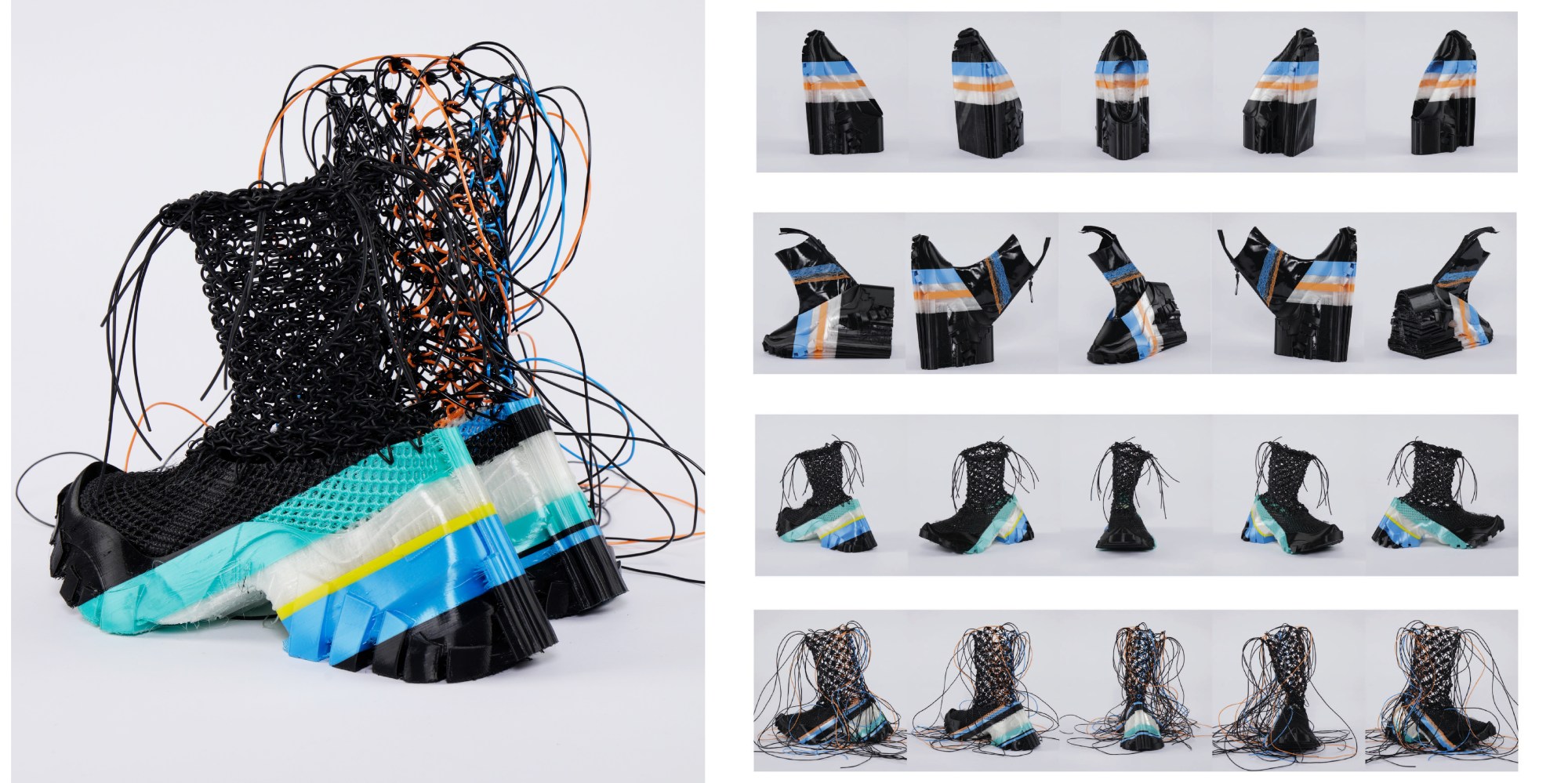
“My aim with ‘shift +’ was to explore a way to help to reduce the impact traditional footwear has on the environment, creating multi-coloured, mono-material, zero-waste 3D printed structures to create imaginative and sustainable shoes. I see my designs as walking art pieces. It’s about innovating, re-updating, infiltrating. It is about being progressive, innovative and playful to explore the possibility of future footwear through using 3D printing technology.
“My interest in 3D printed technology began when I studied at London College of Fashion. My final BA work was a combination of traditional shoemaking techniques with a 3D-printed architectural heel. At the end of my first year on the MA at RCA, I decided to buy a 3D-printing machine. Most of my time, I stayed at home building 3D models without using equipment at RCA. The downside to creating in quarantine, though, was not able to communicate with technicians, tutors and classmates in person.”

Sam Jamieson
“My practice always begins with the community that surrounds me. I am fascinated by the way in which they negotiate the world and the spaces in which they exist. I focussed within this context on moments in nightlife, and the tensions that arise there between intimacy, desire and community.
“I started by responding to denim as a fabric. I love the historical contexts of the denim within queer culture and wanted to decode these tropes of masculinity and really question and distort a perceived solid masculinity into something that became a contradiction of soft fluidity and collision. I wanted to explore masculinity as an entity that wasn’t simply subjected to maleness but could be revealed as tender, exposing and honest.
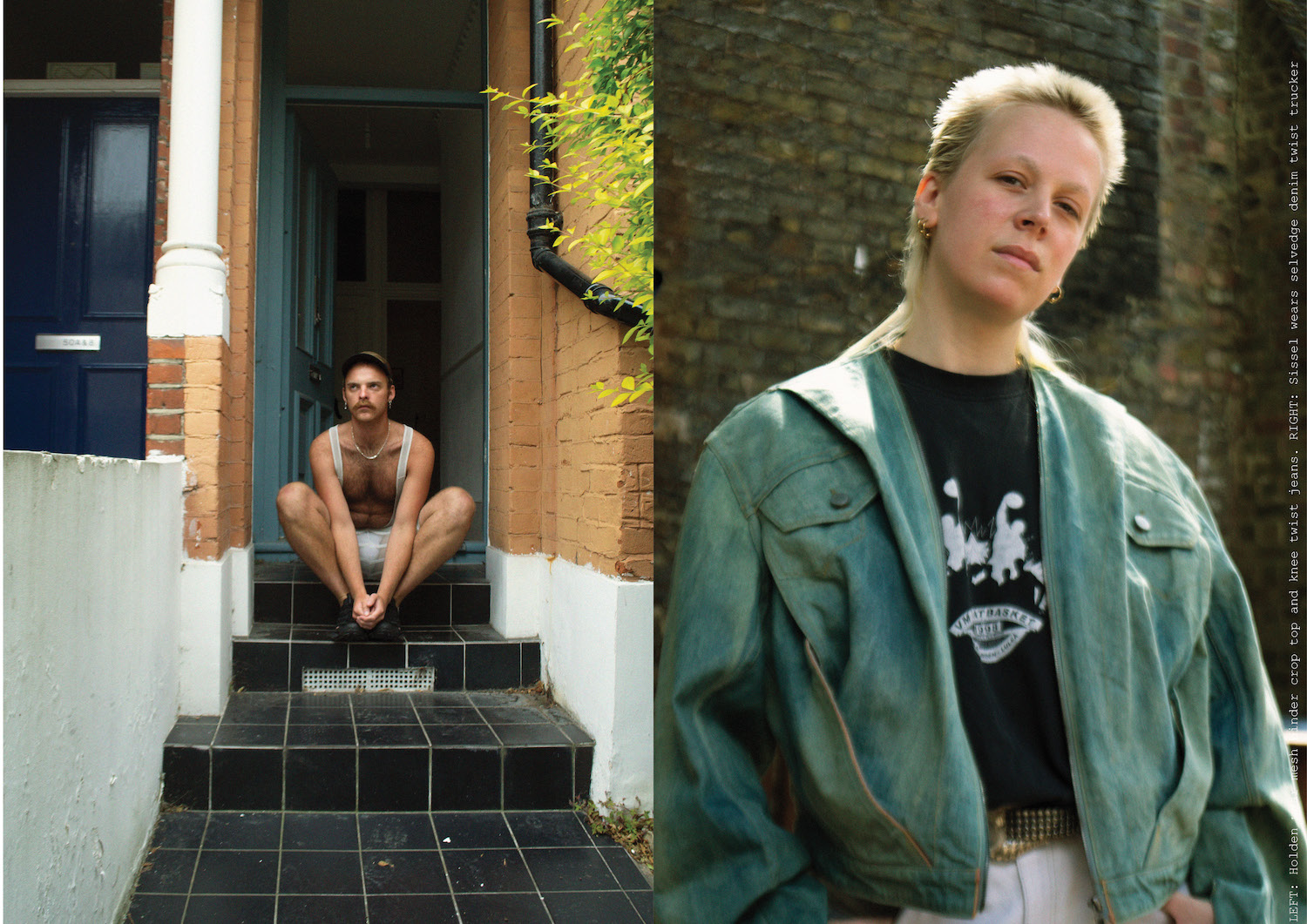
“When the Black Lives Matter movement started to gain momentum, my work temporarily kind of went out the window. It felt more urgent for me to be out there calling out institutions and being at protests; using my privilege as a non-Black POC to fight against injustice. My work has always been inherently about my queerness and queer people and it will always continue to be so; partially in terms of the themes I explore, but also in terms of who I collaborate with and involve in my life.
“RCA has given me a perspective of fashion beyond just making clothes though. It’s fashion as identity, as a means of validating the individual and breaking down archaic colonial notions of which bodies are valid and which are not. Also, fuck you JK Rowling.”
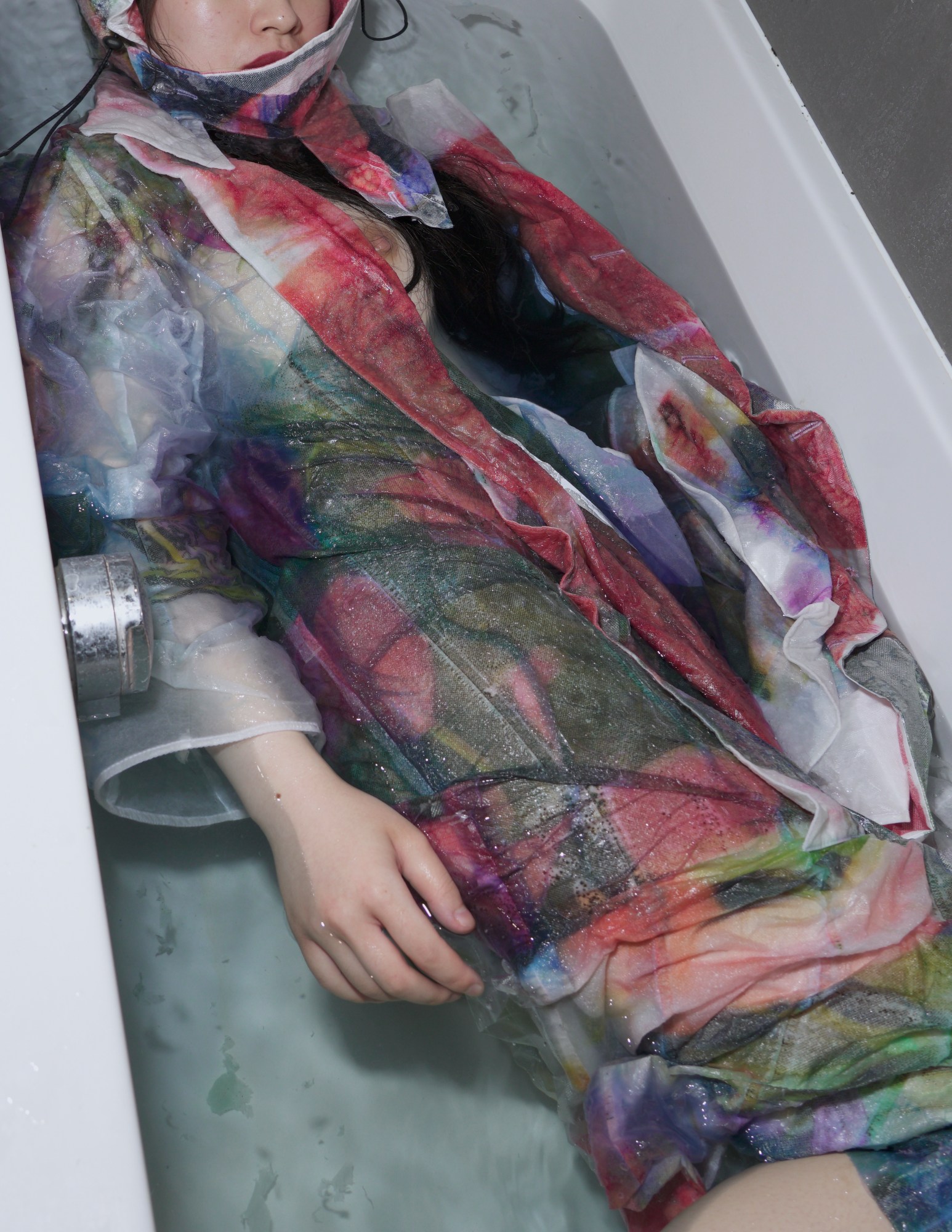
Tianan Ding
“My collection, ‘Revalue’, is a playful and critical experiment on clothes’ fabrication, cost, and function. A kitchen paper towel jacket; a leather t-shirt: these two items, with their very different, reversed materialities are representative of my collection. Water is another material I use: by dissolving, dripping, and fading away, my garments as a metaphor for the deconstruction of structure, function, and value.
“One of my focuses is on the controversy of value and affordability in fashion, especially mainstream streetwear which is currently hyped. We celebrate that streetwear has become the new luxury and ‘high fashion’ flatters the young generation by producing ‘streetwear’. Ironically, though, most young authentic streetwear wearers can’t afford it. What is the streetwear that advocates for the young generation? What’s ‘affordable cool’?
“My pursuit as a designer is this affordable coolness; affordability is embedded within my message of equality. It’s a statement that I am not making fashion exclusively for an elite.
“As a Chinese designer, these months have been a tough and educational time for me. I used to prefer to make garments that were simply beautiful and less opinionated; now, I am more determined to design with timeliness, honesty, to speak for my community and other minorities.
“This pandemic situation has been an upset, but an important moment in my life; it has kicked me out of student status in advance, and also warned me that there is no going back to ‘normal’.”
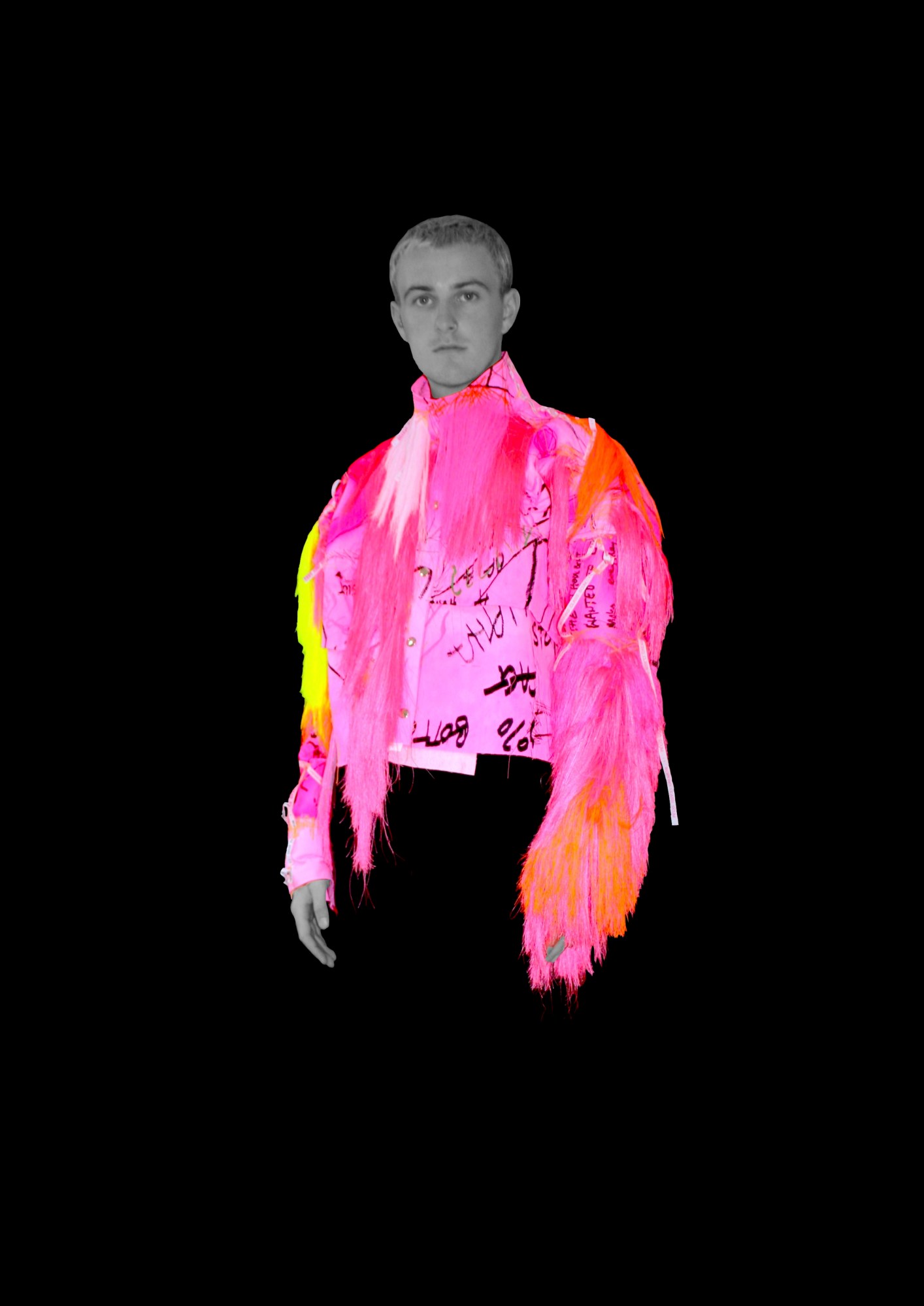
Jake Treddenick
“We live in times of manipulation. The politicians are inadequate, the stereotypes are jokes and the genders we adhere to are crumbling around us. They demonise, demoralise and drain the disadvantaged. Money politics leads to bullshit social injustice. We are cabinets of curiosities to the elite bureaucracy. They smother us. Who the fuck are them to decide our future? We are WORKING CLASS SCUM!
“My collection is an investigation of the roles of the ‘masculine’ within class structures, through humour and the contrasts of identities, whilst researching traditional embroidery techniques to create vivid textures in a modern context.
“When I started researching the collection in 2019 I was fascinated with this idea of clothing being referred to as ‘peacock pieces’. The idea that, in museums, we see flamboyant and extroverted pieces that give a distorted view of history. They’re cabinets of curiosities, and, as a working-class northerner, I felt like the class systems you are placed into become a curiosity to the middle and upper classes, who can view you whenever they want to. “Not having access to RCA’s print, dye rooms or embroidery machinery for someone who is a texture fanatic was devastating. I had to create new ways of doing this. It wasn’t about stopping just adjusting. The bathtub became a dye tub, the living room wall became a spray paint booth and a desk became a fringe making station. Utilising what I had pushed me into a new world where I appreciated simple things like embroidery threads and how to elevate texture with poster paint bought from the local art store.”
